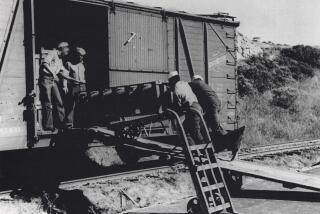Admiral Links Accidents to Letdown
- Share via
WASHINGTON — A rash of Navy accidents may signal an outbreak of complacency among Navy personnel following completion of stressful ocean maneuvers, Chief of Naval Operations Adm. Carlisle A. H. Trost told a congressional committee Thursday, the second day of an unprecedented Navy-wide safety review.
“Are we saying to ourselves: ‘OK, the hard stuff’s over, this is a piece of cake’?” Trost mused before the Senate Armed Services Committee. The sudden spurt in mishaps, many of which came on the heels of a virtually accident-free Pacific exercise, “does lead one to conclude that perhaps people are more safety-conscious when operation tempo increases,” Trost said.
Trost said “we place strong emphasis on supervisor and officer oversight,” but several senators nevertheless harshly criticized the Navy for lapses in managing its personnel.
In San Diego, Rear Adm. Phil Anselmo, Commander, Fighter Airborne Early Warning Wing Pacific at Miramar naval air station said: “We have Navy operations worldwide--we are under tremendous pressure. With increasing pressure economically and you tell us to do the job with less people and less money--we are definitely going to have to come up with another safety equation to be able to do it.
“I’m not frustrated, I am concerned with economics and cuts that affect us. We’ve got to be smart managers.”
As the safety review kicked into gear Thursday at Miramar, Anselmo joined about 500 Navy personnel in walking the 1.5 million square yards of runways, aprons, and taxiways looking for refuse such as stray screws or bolts. Even tiny pieces of metal or refuse could get sucked into an engine and cripple it, said Flag Lt. Chris Liptak. For the Navy, the event could be both deadly and expensive, since an F-14 Tomcat fighter jet’s engine costs about $1.5 million.
In Washington, Trost and other naval officials also faced harsh criticism for the Navy’s probe of the April 19 explosion aboard the battleship Iowa, which killed 47 sailors.
In concluding that the blast probably was a deliberate act by Gunner’s Mate Clayton M. Hartwig, the Navy disregarded glaring lapses in Navy safety practices and personnel procedures, congressional critics charged.
“This is an appalling, appalling situation aboard a capital ship of the U.S. Navy,” said Sen. John Glenn (D-Ohio). Hartwig and several other sailors were killed in the explosion were from Ohio.
Glenn repeated a litany of management shortcomings aboard the Iowa, ranging from the unauthorized live-firing experiments aboard the ship to inadequate training and certification of sailors.
Though the Navy’s investigation called the deficiencies “a foundation for disaster,” the probe concluded that they did not cause the April blast or contribute to the loss of lives.
Other senators and critics of the Navy joined forces to blast investigators for discounting evidence contradicting the official conclusion that Hartwig probably set off the explosion in a suicide attempt.
“It is a report that seems based on supposition and guesswork rather than fact and physical evidence. It is in short a report that appears to be unraveling” said Sen. Alan J. Dixon (D-Ill.).
“I do not think we can have this flawed investigation stand as the truth of what happened,” added Dixon, who called for an agency separate from the Navy to conduct a new probe.
In the face of a barrage of criticism, Navy Rear Adm. Richard D. Milligan, who directed the probe, staunchly defended his panel’s conclusion. “I know of nothing that would cause me to change my report,” he said.
More to Read
Sign up for Essential California
The most important California stories and recommendations in your inbox every morning.
You may occasionally receive promotional content from the Los Angeles Times.











